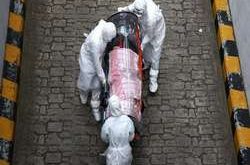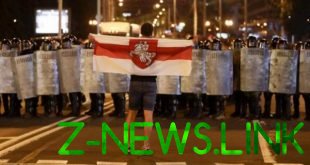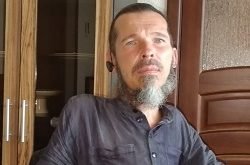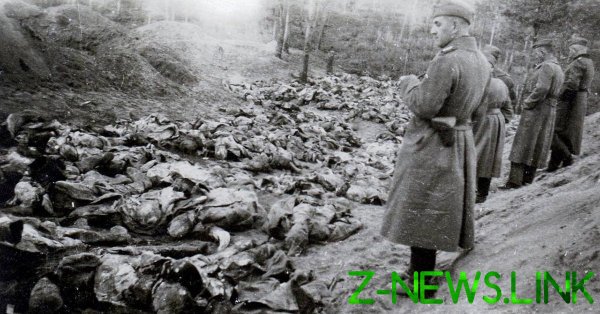
80 years ago, on 5 March 1940, the Politburo decided to destroy the Polish prisoners of war who were held in Soviet camps. How many people were captured and under what conditions, contained what was shot and what he wrote in the diary before he died? Have tried to answer these and other questions as simply as possible.
1
What is Katyn?
From the point of view of geography Katyn — it is an ordinary village in the Smolensk region of Russia, 18 km to the West from the regional center. Now it is home to more than a thousand people. Whence came the name of the village is unknown. There are several versions. From the verb “to roll”, from the ancient “Katun” (mill, camp). Or the word “cat” (in Belarusian the executioner). After all, Smolensk became part of Russia only in 1667, and before that was part of the on.
Famous Katyn was due to two tragic events: death in 1940, the year of Polish officers and deaths in these areas in 2010, the Polish elite (including the President of the country Lech Kaczynski), which was headed for the ceremonies on the occasion of the 70th anniversary of the Katyn massacre. In this text we will tell you about the first of these events.
2
What was the background of the Katyn tragedy?
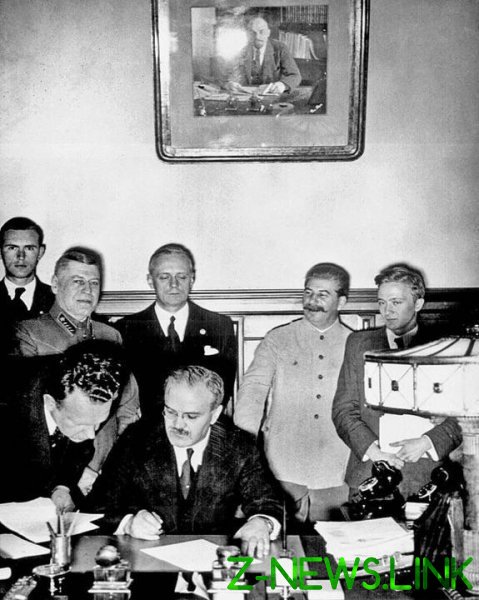
The people’s Commissar of foreign Affairs of the USSR Vyacheslav Molotov signed the Soviet-German agreement. Behind him, the Minister of foreign Affairs of Germany Joachim von Ribbentrop and Joseph Stalin. Source: wikipedia.org
23 August 1939 was signed the Treaty of non-aggression between Germany and the Soviet Union (known as the Molotov — Ribbentrop Pact). The Pact was supplemented with Secret additional Protocol, which delineates the sphere of influence of the two countries in Eastern Europe, “in the event of a territorial and political rearrangement”. In fact, it was the annexation of neighbouring States and the partition of their territories.
According to the Protocol, Poland was divided along the line of the rivers Narev, Vistula and San. That is, the territory of Western Belarus and Western Ukraine fell into the Soviet sphere of influence.
On 1 September 1939, Germany invaded Poland. But Stalin waited for a minute to public consciousness as the main culprit of the war was perceived by Hitler. Only on 17 September the red Army crossed the Soviet-Polish border.
Marshall rydz-smigly, head of the Polish Armed forces, gave the order to resist the red Army only in the event of an attack on the Polish part of or attempts to disarm them. But the Soviet troops was moving mostly on highways and never stayed, so collisions with poles were not so much.
On September 20, the Red Army occupied Grodno. German General Kurt Tippelskirch wrote in his “History of the Second world war”, in Soviet captivity was about 217 thousand Polish soldiers and officers. Polish historians (for example Czeslaw Madajczyk) called the other figures: about 250 thousand.
3
Who of the prisoners were in the camp, where were they?
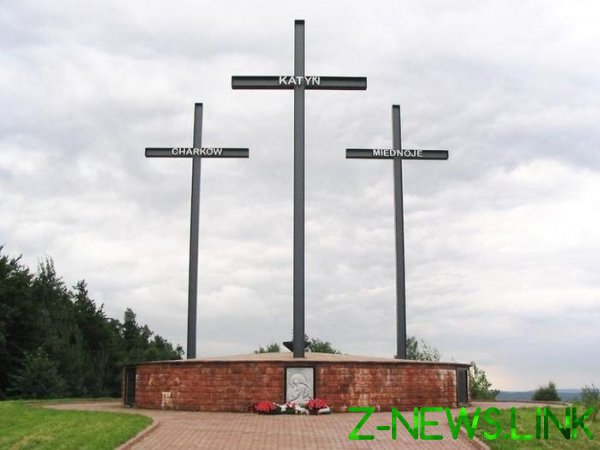
A memorial in Katyn. Photo: wikipedia.org
Stalin gave the fate of the prisoners in the hands of the NKVD. September 19, 1939 the people’s Commissar of internal Affairs Lavrenty Beria signed the order about formation of Management on Affairs of prisoners of war.
Initially they were placed in temporary camps in Belarus and Ukraine, near the old Soviet-Polish border. Then road the prisoners dispersed.
Soldiers — Ukrainians and Belarusians by nationality — was released to go home. The prisoners formally released, but sent to the construction of roads, enterprises of heavy metallurgy, etc.
More than 40 thousand poles were sent on exchange from Germany (they were born in that part of Poland which was under the control of the Reich). Among them were Jews, to whom the return was threatened with death.
— Comrade chief! Ask for Your order to leave us here, as we don’t want to go to the Germans. Malkovich Moses, a worker, a tailor, located in Warsaw, since 1905, are requested to leave Russia, — wrote one of these prisoners. But their petitions were unheeded.
For the elite was formed separate camps. Polish police, gendarmes and jailers were sent to the Ostashkov camp (now Tver oblast, Russia). Ironically in the police force dominated by workers and peasants, who, because of health and age could not serve in the regular army. Generals, officers and high officials in Starobilsk (now Luhansk region of Ukraine), non-commissioned officers and privates (natives of that part of Poland which was occupied by the Germans) — in the Kozelsk camp (now Kaluga oblast of Russia).
Polish military doctors, who also was in the Starobelsk camp, said that according to the Geneva Convention should be released immediately after the end of the war. The camp commander has requested Moscow. They responded:
— Geneva Convention is not a document that you have to be guided. Follow the work directives of the NKVD for prisoners of war.
4
The conditions in which prisoners were kept?

Photo: Reuters
Prisoners were kept in different camps, therefore, we focus on one of them: Kozelsk. As he writes in his book, “Katyn: a Crime against humanity” Natalia Lebedeva, a leading expert on this issue, the camp was on the territory of the former monastery, where there were several dozen stone buildings and churches. People lived in the cathedrals, very tight lined with multi-tiered bunks in the former cells and the refectory.
— 500 people Packed like sardines on three tier bunks. Ascent and descent is dangerous to life, but nothing is wrote in the diary of one of the prisoners.
The camp was not suited to the maintenance of a large number of people. As of February 1940, the camp was 4486 people. 4347 of them poles. And 89 of the Jews, 23 Belarusian, 11 Germans, 8 Lithuanians, 6 Ukrainians, 1 Czech and 1 Georgian.
— There was an acute shortage of water due to the lack of necessary equipment to the water tower. This situation prevailed through most of the winter, as a result of the people tortured by lice and bedbugs. The first time there were no brooms, rags, matting, rooms not cleaned, the kitchen was covered with mud. It was not enough toilets, they are not fumigated, cleaned, wrote Lebedev.
Prisoners were woken at 7 a.m., though no need it was not. 7.30 to 8.30 was a morning practice, then Breakfast. From 9.30 to 16.30 covered the camp, but in practice it was busy, not all and not every day. Had dinner in 21 hours, from 22 to 23 held formal verification, and then a bounce.
The daily food intake consisted of 800 grams of bread, 30 g sugar, soup for lunch, cereal for Breakfast and dinner. Officers weekly should also tea, tobacco, matches and soap. But very often they did not receive them. Not always was the bread. As for his absence, and theft protection.
5
How was the shooting?
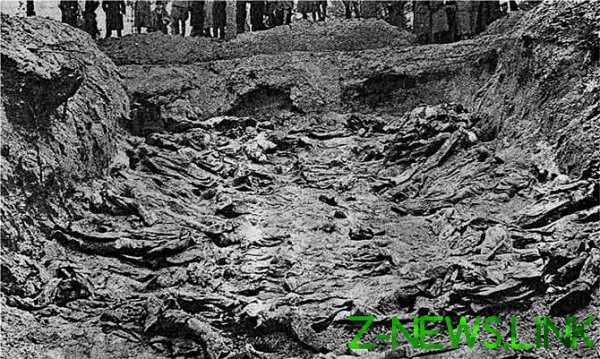
Excavated grave in Katyn. Photo: wikipedia.org
From 1 April 1940 the chief of the camp every day came the lists for a few hundred people. The chiefs made out these lists as the outfits on the export of prisoners and sent them to either the internal prison of the NKVD or in the Katyn forest.
<hr/>
From the Polish the diary of major Adam Solsky, who wrote about the last hours of life of Polish officers.
“9.04. A few minutes before five in the morning. Early rise in the prison wagons and preparing to exit. Where we will be taken on the machines. What’s next?
9.04. Not yet dawn. The day begins strangely. Transportation to “the crow” (scary!). Brought [us] somewhere in the forest. Like a summer house. Here again inspection. Took the clock it was 6.30. (8.30). Asked about the scapular, which… took the ruble, belt, pocket knife.”
On this record is dropped.
<hr/>
As the historian Natalia Lebedeva, who studied the materials of the Polish red cross (the organization was researching the graves in 1943), “prisoners of war shot in uniform, with medals. The burial ground was discovered documents, letters, diaries, Polish coins, large bills PLN, etc. the Pathologist concluded that the cause of death in most cases was a gunshot wound of the skull, damaging vital centers of the brain. Only occasionally was discovered to double or even triple gunshot wounds to the back of the head. Sometimes people finished four-sided bayonets. (…). In 20% of cases the hands of the officers were tied behind his back with wire or braided line with a double loop. Apparently, this was done against those who might resist”.
<hr/>
From the testimony of the former employee of the Smolensk NKVD Peter Klimov, a former janitor Smolensk inside of the prison.
— In a small basement room was the hatch, sewer. The victim turned and opened the hatch, his head was placed on its edge and shot in the head or in the head (everything), one of the victims, I remember, was cut open the belly… Shot almost every day in the evening and were taken to Goat Mountain and back to 2 o’clock in the morning. The car was loaded rake bodies used for 30-40 people in one car. Then the corpses were covered with tarpaulin and transported.
<hr/>
After each execution in Moscow left a coded message about the job. Of course, the word “execution” is not used (for example, the document could have been written “Executed 292”.
6
Who made the decision to kill the prisoners?
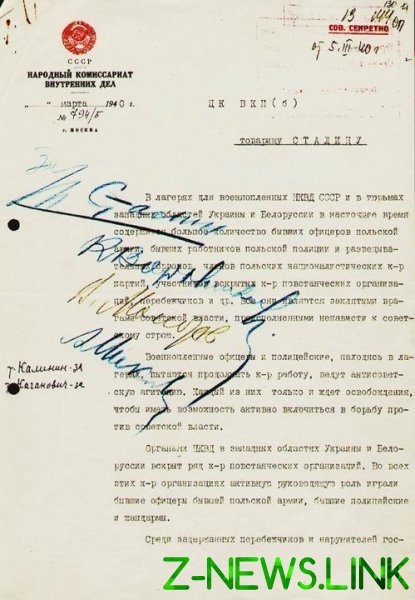
Note NKVD was written not later than March 5, 1940 of the Polish prisoners of war, signed by Lavrenty Beria. Photo: katyn.ru
In early March 1940 the NKVD head Lavrenty Beria sent Stalin a letter. He proposed to consider the case “in a special manner with them [prisoners of war] of capital punishment — shooting”.
Stalin wrote a letter to Beria “for”. The question issued by a decision of the Politburo from 5 March 1940.
<hr/>
1. To offer the NKVD:
1) Cases that are in the camps *prisoners of war* 14,700 people of former Polish officers, officials, landowners, policemen, intelligence agents, gendarmes, settlers and jailers,
2) and also the cases on the arrested and located in prisons in the Western regions of Ukraine and Belarus in the amount of 11,000 people members of various C-R [counterrevolutionary. — Approx. TUT.BY] espionage and sabotage organizations, former landowners, factory owners, former Polish officers, officials and defectors is to consider in a special manner, applying to them the highest measure of punishment — shooting.
II. The cases hold without calling those arrested and without presenting charges, the decision to end the investigation and indictment in the following order:
a) for persons in pow camps — according to information submitted by Management on Affairs of prisoners of war of the NKVD of the USSR.
b) for persons arrested — according to information from the cases submitted to the NKVD of the Ukrainian SSR and the NKVD of the Byelorussian SSR.
III. The cases and the decision to assign three, consisting of comrades Merkulov, Kabulov and Bashtakov (head, 1st special Department NKVD USSR).
<hr/>
Vsevolod Merkulov and Bogdan Kabulov was a Deputy of Beria. In 1953, they will be executed in the case of the cartridge.
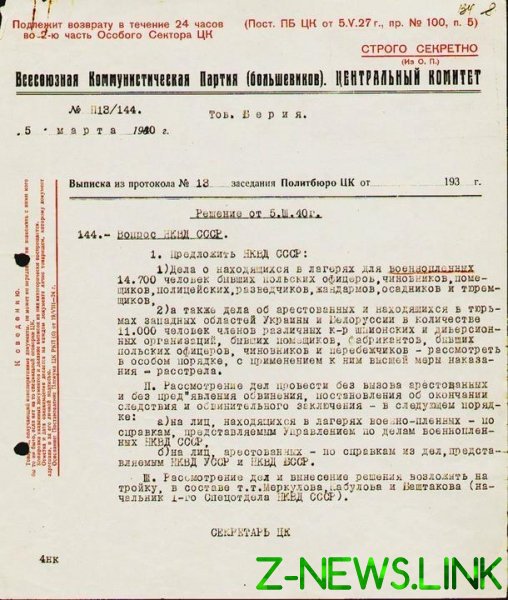
Extract from the minutes No. 13 of the Politburo of the CPSU (b) “Special folder” on March 5, 1940 “Question of the NKVD”. Photo: katyn.ru
Soon things began to receive prisoners in the NKVD, was processed there. They have drawn up a hit list that was received on the signature of Beria and Merkulov.
7
How many people were shot in Katyn?
Just to clarify: Katyn in the question is used as an umbrella symbol of the atrocities of the NKVD in relation to Polish. Why?
The executions were carried out in several places. In the Katyn forest were found graves 4421 people (prisoners of Kozelsk camp), 3820 people around Kharkov (from Starobelsk camp), 6311 Kalinin, now Tver region (from the Ostashkov camp). Even 7305 were shot in prisons in Belarus and Ukraine. A total of 21 857. These people are the victims of Katyn.
In the Ukrainian archives were found a list of executed prisoners, which was 3435 people in different prisons. If you take away this figure from 7305, get “the Belarusian Katyn list”, where it should be 3870 people.
The question of the existence of the list has long been controversial.
We raised all the files, and not just KGB, all the government agencies. We have no pole on the territory of Belarus destroyed, the shot was not, — said in 2011 Alexander Lukashenko. — We were only transit points. The poles that went through them, I concentrated, in my opinion, mainly in Russia and perhaps in Ukraine. We found the documents, the letter of the leaders of the NKVD that in Belarus there are no poles to the destruction that we only had transit points.
However, in 2012, Natalia Lebedeva found in the archives of the 1996 names of poles deported by the NKVD in Minsk, where they were probably shot. And in 2013 published a fragment of a reconstruction of the Belarusian Katyn list, which includes 98 names of Polish citizens. It was created based on the comparison of two lists of Polish citizens who disappeared in 1939-1940 in areas of the North-Eastern regions II of the Commonwealth and the persons mentioned in the lists of escort troops of the NKVD, transported to Minsk prison in 1939-1940.
8
Why was this a hard decision?
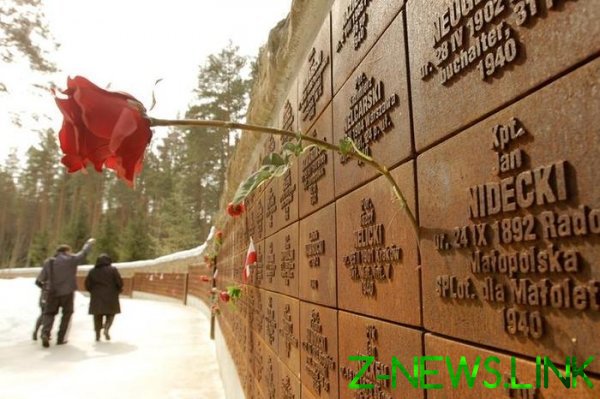
Photo: Reuters
Officially the cause of the shooting no one explained and formulated. Therefore, we can only guess about the motives of this crime.
In the so-called Patriotic literature Katyn often interpreted as a revenge of Stalin to the poles. They say, in 1920, the Red army suffered a defeat (a member of the Military Council of one of the fronts was Stalin), and then a prisoner was tortured thousands of red army. But if it was about revenge, she would have followed at once (in autumn 1939 instead of spring 1940). If you consider this version, only as secondary.
Can fully agree with Natalia Lebedeva, the main cause of the destruction of the Polish officers was “undermining Polish statehood.”
Prisoners of Kozelsk, Starobelsk and Ostashkov was a military and intellectual elite of Poland. They were determined to fight for the independence of his country, to obstruct the efforts of the Stalinist regime in imposing its orders on ceded to the Soviet Union territories. (…) and police officers, after spending more than six months in fairly severe conditions of captivity, was not broken psychologically and morally. They have not renounced their country, nor religion, nor political, nor moral values. The hopes of the Soviet leadership to “re-education” at least part of the workers and peasants, representatives of intelligentsia, dressed in uniforms, were in vain. Dissent to overcome failed. Therefore, according to the logic of Stalin and his entourage, it was necessary to eliminate its speakers.
However, there are other reasons. In the prewar years, “bourgeois” Poland was perceived by the enemy of the Soviet Union. That is, to their representatives, a priori hostile.
At the same time “Stripping” the elites could be a step for the subsequent Sovietization of Poland, which occurred after 1945.
9
As it became known about the Katyn tragedy?
Corpses of prisoners in Katyn were buried in the area of DACH regional NKVD. The place was chosen not by chance: in time of peace, there could hardly be someone to get in. But in 1941 the Great Patriotic war, and the Smolensk region was occupied by Nazi Germany.
In March 1942 the poles who worked in the local construction battalion excavated the Katyn graves. But the Germans were interested in the Katyn question a year later: only in April 1943, his research was conducted by field police. Then the whole world found out that in the Katyn forest was found graves of Polish officers.
Lovers of conspiracy theorists like to focus on this fact, saying that a reason the remains were found by the Germans. Yes, the Third Reich tried to use this fact in their ideological struggle against opponents. But the very fact of Soviet crimes is no change.
Until June of 1943 took place the exhumation, which was also attended by poles from the technical Commission of the Polish red cross. The findings were clear: in these places the executions carried out by the NKVD.
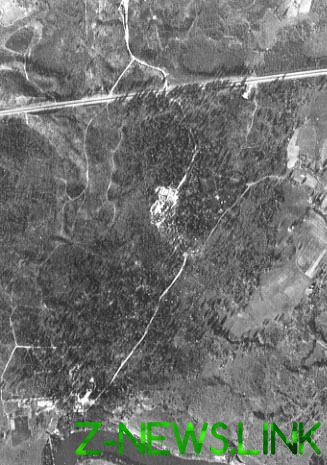
The Hole “Goats ‘ Mountains”. The aerial photo made on 13 October 1943. At the top of the road Smolensk-Vitebsk, below — the Dnieper, a little above the Dnieper — the summer residence of the NKVD, in the middle of a road going to it from the highway through the forest — the clearing of the graves of Polish prisoners of war. Photo: wikipe
In the summer of 1943 Smolensk was liberated by the red Army. But a preliminary investigation was conducted not by a Special Commission headed by academician Burdenko, and the state security organs. They were headed by Vsevolod Merkulov, who in 1940 was one of the organizers of the shootings.
The NKVD, under the leadership Merkulova produced false witnesses and invested in several graves documents a later time. And only in January 1944, the Politburo adopted the decision “On the establishment of a Special Commission”, which drew the desired results.
In Soviet times, Soviet involvement in the Katyn crime was denied.
Only in 1990, when Moscow with official visit, Polish President Wojciech Jaruzelski, TASS issued an official statement in which the Soviet Union recognized his guilt in the Katyn tragedy.
<hr/>
From the TASS statement of 14 April 1990
Most recently, the Soviet archivists and historians discovered some documents on Polish soldiers who had been held in Kozelsk, Starobelsk, Ostashkov camps, the NKVD of the USSR. From them follows that in April-may 1940, of the approximately 15 thousand Polish officers held in these three camps, 394 were transferred to the Gryazovets camp. The main part of “placed at the disposal” of the NKVD, respectively, Smolensk, Voroshilovgrad, and Kalinin regions and nowhere else in the statistical reports of the NKVD is not mentioned.
Identified archival materials in their entirety lead to the conclusion that the direct responsibility for atrocities in the Katyn forest Beria, Merkulov and their henchmen.
The Soviet side, expressing its deep regret in connection with the Katyn tragedy, declares that it is one of the serious crimes of Stalinism.
Copies of the documents handed over to the Polish side. Search archive materials continues.
<hr/>
Also, Gorbachev gave Jaruzelski copies of the lists. In them were the names of the poles who were in Kozelsk, Ostashkov and Starobelsk camps.
Mikhail Gorbachev became the first Soviet leader, who acknowledged the Katyn crime. But the whole truth he never told.
In 1957, the KGB Chairman Alexander Shelepin wrote a note to Nikita Khrushchev. He called the number of murdered in Katyn people (21 857, we announced it in the text).
<hr/>
From the note of the Chairman of KGB of the USSR A. N. From Shelepin on 3 March 1959
The Committee of state security under the USSR Council of Ministers since 1940 are kept the accounts of the case and other materials on the shot in the same year, prisoners and interned officers, gendarmes, police, settlers, landowners, etc. persons of the former bourgeois Poland. All the decisions of the special Troika of the NKVD were shot 21,857 people. (…). Since the named operation, that is, since 1940, no reference to these cases were not given to anyone and all things in number 21 857 stored in a sealed room.
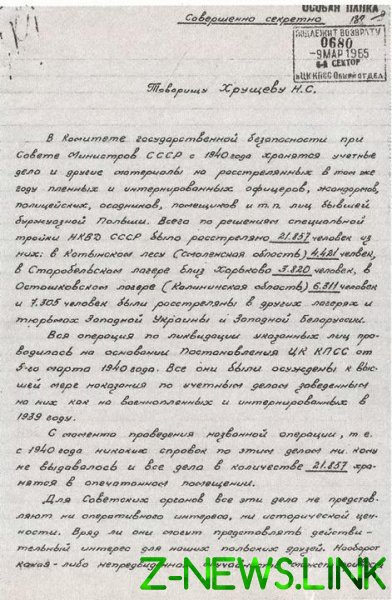
Letter To Alexander Shelepin To Nikita Khrushchev. Photo: katyn-books.ru
For the Soviet authorities, all these cases do not represent an operational interest or historical value. They are unlikely to represent a real interest for our Polish friends. On the contrary, any unforeseen accident may lead to rusconcert conducted the operation with all the undesirable for our state consequences. Especially in relation to the shot in the Katyn forest there is an official version (…). Based on the above it seems appropriate to destroy all of the accounts in the case of the persons shot in 1940 in the operations referred to above.
<hr/>
The main documents were destroyed. The rest (including the note of Beria to Stalin, the decision of the Politburo about the shooting and the letter from Shelepin) stored in the personal safe of Konstantin Chernenko (the future Secretary General, and then an influential officer of the Central Committee of the Communist party). When Andropov and Gorbachev became General Secretary, they are acquainted with these documents. That is, Gorbachev knew about them but remained silent.
In December 1991, Gorbachev resigning, handed these documents to Boris Yeltsin. In the fall of 1992, the package has been opened, copies of the documents were handed over to Poland and published in the scientific journal “Questions of history”. In this case, the question of who were shot in Katyn, the point was put.
Two years before this, in 1990 the Chief military Prosecutor of the USSR opened a criminal case which was discontinued in 2004. Of the 183 volumes of the case, the Polish side was handed 67. The remaining 116, according to the military Prosecutor, contained state secrets. Killed at Katyn were not recognized as victims of repression, the case of rehabilitation was discontinued.
Four years later, in 2008, the court rejected the complaint of relatives of the officers on the actions of the Chief military Prosecutor’s office. Prosecutors said in court that as the bodies of the officers were not identified, and to rehabilitate certain.
Read more: https://news.tut.by/culture/674784.html
© 2020, paradox. All rights reserved.



